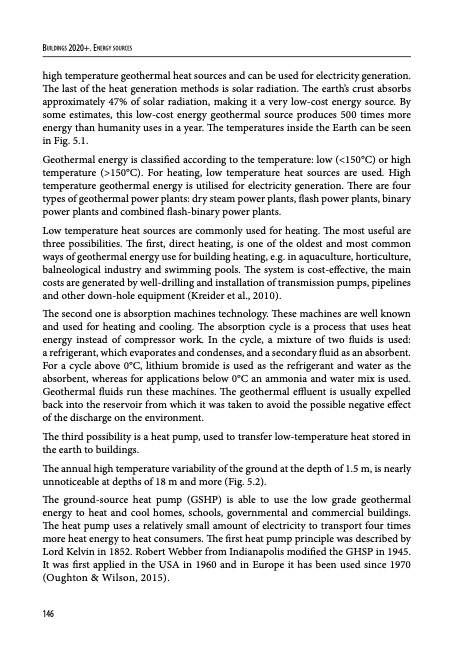
PDF Publication Title:
Text from PDF Page: 002
Buildings 2020+. EnErgy sourcEs high temperature geothermal heat sources and can be used for electricity generation. The last of the heat generation methods is solar radiation. The earth’s crust absorbs approximately 47% of solar radiation, making it a very low-cost energy source. By some estimates, this low-cost energy geothermal source produces 500 times more energy than humanity uses in a year. The temperatures inside the Earth can be seen in Fig. 5.1. Geothermal energy is classified according to the temperature: low (<150°C) or high temperature (>150°C). For heating, low temperature heat sources are used. High temperature geothermal energy is utilised for electricity generation. There are four types of geothermal power plants: dry steam power plants, flash power plants, binary power plants and combined flash-binary power plants. Low temperature heat sources are commonly used for heating. The most useful are three possibilities. The first, direct heating, is one of the oldest and most common ways of geothermal energy use for building heating, e.g. in aquaculture, horticulture, balneological industry and swimming pools. The system is cost-effective, the main costs are generated by well-drilling and installation of transmission pumps, pipelines and other down-hole equipment (Kreider et al., 2010). The second one is absorption machines technology. These machines are well known and used for heating and cooling. The absorption cycle is a process that uses heat energy instead of compressor work. In the cycle, a mixture of two fluids is used: a refrigerant, which evaporates and condenses, and a secondary fluid as an absorbent. For a cycle above 0°C, lithium bromide is used as the refrigerant and water as the absorbent, whereas for applications below 0°C an ammonia and water mix is used. Geothermal fluids run these machines. The geothermal effluent is usually expelled back into the reservoir from which it was taken to avoid the possible negative effect of the discharge on the environment. The third possibility is a heat pump, used to transfer low-temperature heat stored in the earth to buildings. The annual high temperature variability of the ground at the depth of 1.5 m, is nearly unnoticeable at depths of 18 m and more (Fig. 5.2). The ground-source heat pump (GSHP) is able to use the low grade geothermal energy to heat and cool homes, schools, governmental and commercial buildings. The heat pump uses a relatively small amount of electricity to transport four times more heat energy to heat consumers. The first heat pump principle was described by Lord Kelvin in 1852. Robert Webber from Indianapolis modified the GHSP in 1945. It was first applied in the USA in 1960 and in Europe it has been used since 1970 (Oughton & Wilson, 2015). 146PDF Image | Heat Pumps 978-83-65596-73-4

PDF Search Title:
Heat Pumps 978-83-65596-73-4Original File Name Searched:
Buildings-2020-part2-rozdz5.pdfDIY PDF Search: Google It | Yahoo | Bing
CO2 Organic Rankine Cycle Experimenter Platform The supercritical CO2 phase change system is both a heat pump and organic rankine cycle which can be used for those purposes and as a supercritical extractor for advanced subcritical and supercritical extraction technology. Uses include producing nanoparticles, precious metal CO2 extraction, lithium battery recycling, and other applications... More Info
Heat Pumps CO2 ORC Heat Pump System Platform More Info
| CONTACT TEL: 608-238-6001 Email: greg@infinityturbine.com | RSS | AMP |